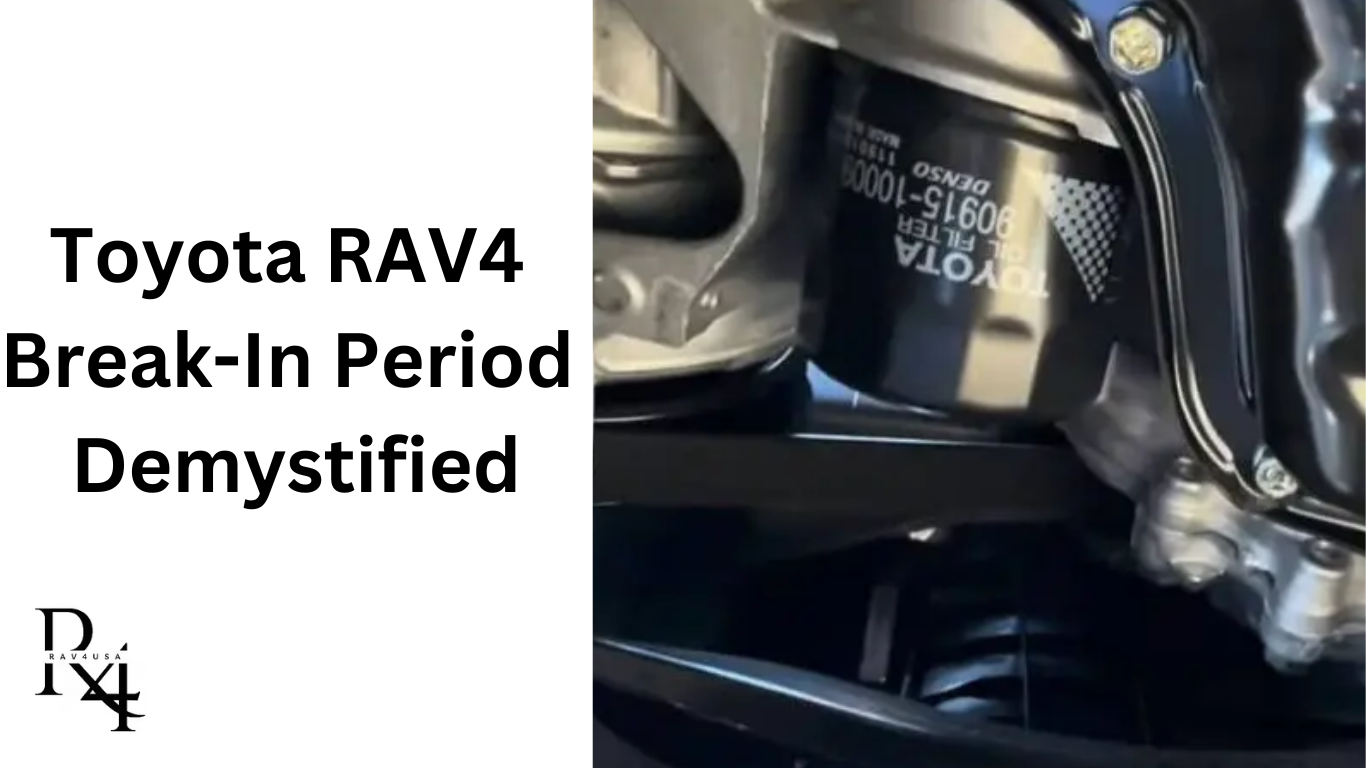
Getting to know your new Toyota RAV4 is exciting. But, let’s discuss the break-in period. You might not think about it right away. You might be pondering over questions like, “Do modern engines really even need a break-in period?” or “How does this affect my vehicle’s performance?”
Let’s explore the fascinating world of the Toyota RAV4 break-in process. We’ll discuss if it’s needed for today’s advanced engines. Also, we’ll cover how to care for your SUV during its early miles. By the time we’re done, you’ll have a handy guide to keep your RAV4 in top shape while uncovering some surprising truths. Buckle up—this is going to be an engaging ride!
What Is the RAV4 Break-In Period?
Think of your Toyota RAV4’s engine as its heart. It’s a finely tuned machine that keeps everything moving. When that heart is brand new, it needs a bit of TLC before you push it to its limits.
The break-in period is a gentle, early phase in your RAV4’s life. It lets the engine parts like the piston rings and cylinder walls, settle in. Think of it as a warm-up exercise to ensure long-term performance and durability.
But here’s a twist: some folks argue that modern engines are already broken in at the factory. Is that true? Hold that thought—we’ll get into the science in just a bit!
Toyota RAV4 Break-In Guidelines for a Smooth Ride
Taking care during your RAV4’s break-in period can pay off big time. Here’s what Toyota recommends:
For The First 200 Miles (300 KM):
- Avoid sudden stops.
For The First 500 Miles (800 KM):
- Hold off on towing.
For The First 600 Miles (1,000 KM):
- Avoid high-speed adventures or rapid acceleration.
- Don’t stick to low gears for too long.
- Mix up your speeds instead of constant cruising.
Pro tip: Many of these guidelines are good habits for everyday driving, not just the break-in period. For instance, varying your speeds and avoiding low gears reduce stress on your engine.
The Science Behind Break-In Debris
Here’s where things get interesting. I came across a video of a real Toyota RAV4 owner. He ran an experiment to answer a burning question: Are modern engines already broken in at the factory?
To find out, they analyzed oil samples taken after the first 1,000 miles and compared them to later samples. The results? Science spoke loud and clear: the engine was not broken in at the factory.
Here’s what happened:
- The first oil sample showed high wear metals: iron, copper, and aluminum. This was a clear sign that the piston rings and cylinder walls were still settling in.
- Over time, those metal levels dropped significantly. This proved the engine was breaking in during those early miles.
This experiment shows that even today, engines need a proper break-in period. And it’s not just theory—it’s science-backed evidence!
Why Doesn’t Toyota Use Break-In Oil?
Back in the day, car manufacturers used special break-in oil for new engines. So why don’t they do that anymore? The answer lies in two big changes:
- Shifting Consumer Habits More people lease cars today instead of buying them. Leased vehicles often get less maintenance. The owner knows they’ll return the car. To avoid sludge from break-in oil, manufacturers chose synthetic oil. It lasts longer.
- Fuel Economy Regulations. Modern engines use low-viscosity synthetic oils. They contain advanced friction modifiers. These meet strict fuel economy standards. It boosts fuel efficiency and cuts emissions. However, it may not optimize engine break-in.
In short, dropping break-in oil was a practical, cost-saving choice for manufacturers. But, it doesn’t mean you should skip early engine care!
Why an Early Oil Change Matters
Here’s a hot tip: consider doing an oil change within the first 1,000 miles. This helps remove debris from the break-in process. This includes tiny metal particles from the piston rings and cylinder walls.
Toyota’s maintenance schedule might not call for it. But, this small step can clean your engine and reduce wear. Plus, the oil analysis experiment showed the clear benefits of this. These are, again, lower-wear metals and a healthier engine.
Benefits of a Proper Break-In
Still not convinced? Let’s talk perks:
- Enhanced Performance A well-broken-in engine operates more efficiently, with reduced friction and smoother performance.
- Extended Lifespan By taking care of your engine during its early miles, you set the stage for years of reliable service.
Skipping the break-in period can lead to:
- Excessive oil consumption.
- Accelerated wear on cylinder walls.
- Camshaft and valve issues.
In other words, a little patience now saves you from headaches later.
FAQs
Does Toyota recommend a break-in period?
To maximize the longevity of your Toyota, following a few precautions during the initial miles is essential. For example:
- First 200 miles (300 km): Avoid hard stops.
- First 500 miles (800 km): Refrain from towing trailers.
- First 600 miles (1,000 km): Avoid high speeds and rapid acceleration. Also, don’t drive in low gears for extended periods, and change up your driving speeds regularly.
What is the suggested break-in period for a new car?
Many experts agree that the first 500 miles are critical for breaking in a car. During this time, keep the engine's RPMs low. This helps the piston rings seal against the cylinder walls. Piston rings are essential in preventing oil leaks and maintaining engine efficiency.
What to do after the break-in period?
Once the break-in phase is complete, it's a good idea to adjust your driving habits slightly. In the first 500 miles, vary your speed. Don't push RPMs above 4,000. Also, avoid constant speeds for long periods.
For the first 100 miles, brake gently to ensure proper bedding of the brake pads and rotors. Finally, an oil change after the break-in period can help clear out any debris generated during the process.
What speed should you maintain during the break-in period?
Breaking into a new car properly is still an important practice, even with modern vehicles. For the first 1,300 miles, it’s best to keep the engine RPMs within safe limits.
Experts suggest staying below 3,500 RPM and 90 mph for diesel engines, and under 4,500 RPM and 100 mph for gas engines. This ensures the engine components wear in gradually and evenly.
How long is a typical break-in period in kilometers?
The length of a break-in period depends on the type of vehicle. For motorcycles, the process usually spans the first 500 kilometers (about 300 miles).
For cars, it typically lasts around 1,000 kilometers (approximately 600 miles). After the break-in period, change the oil. This removes any metal particles or residue from the manufacturing process.
Is there a break-in period for the Toyota RAV4 Prime or Hybrid?
Yes, the hybrid and plug-in hybrid models follow the same break-in procedures. But always check the owner’s manual for specific recommendations for hybrid vehicles.
Sources
If you want to learn more about reports on the importance of the break-in period, check the following sources:
Conclusion
Breaking in your Toyota RAV4 might seem old-fashioned, but as science shows, it’s as relevant as ever. Caring for your RAV4 involves much. You must analyze oil samples and understand the choices behind modern engine oils.
So, take it easy in the early miles. Consider an early oil change. And, follow the break-in guidelines. Your RAV4 will thank you with better performance, a longer lifespan, and a smoother ride.
Here’s to happy driving and keeping your RAV4 in tip-top shape—one mile at a time!
